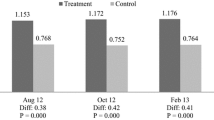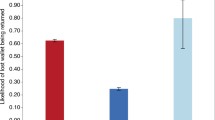Abstract
This article introduces a simple survey method to distinguish between two types of variables that affect happiness—type A, which exerts an absolute effect on happiness, and type B, which affects happiness only through social context. The authors validate the method by comparing its findings with the findings of a theoretically superior but less practical experimental method, and use the method to identify the AB nature of a variety of naturally-occurring variables among both college students and people with work experience. We conclude by discussing the limitation of this method as well as its potential to inform policymakers about where to invest resources in order to improve people’s happiness over time.
Similar content being viewed by others
Notes
To improve a variable means to change it toward the more desired direction and does not necessarily mean to increase its value. For example, to improve the weight of a laptop computer generally means to decrease the weight.
To make the simulated-non-comparative version parallel to the comparative version, we should have asked respondents to suppose that “the average height of men were the same as your height.” rather than to suppose that “every man were of your height.” However, pilot tests found that the two questions produced similar results and the “every man” question was easier to understand than the “average height of men” question.
Because we randomly assigned respondents to the better and the worse conditions, X values were discrete, and theoretically, using regression parameters to calculate AB coefficient is equivalent to using mean differences to calculate AB coefficient. Namely, AB coefficient = βnon-comparative/βcomparative = (hnon-comparative(x1) − hnon-comparative(x2))/(hcomparative (x1) − hcomparative(x2)). Compare this equation with Eq. 1 and the reader will realize that the only difference between ABIS and the experimental method is that ABIS uses simulated-non-comparative means to calculate the non-comparative effect and the experimental method uses real non-comparative means.
In earlier research (Hsee et al. 2009), the authors also investigated whether people could distinguish between type A and type B variables intuitively. In their research they first explained the definitions of type A and type B variables to research participants and then asked the respondents to rate diamond size and bathwater temperature on a four-point scale ranging from 1 (“definitely belongs to type A”) to 4 (“definitely belongs to type B”). Again, the results were in the expected direction (mean ratings were = 1.50 and 3.22 for water and diamond, respectively) but not as close to the experimental results as ABIS.
References
Bandura, A. (1978). Social learning theory of aggression. Journal of communication, 28, 12–29.
Bettman, J., Luce, M. F., & Payne, J. (1998). Constructive consumer choice processes. Journal of Consumer Research, 25, 187–217.
Blanchflower, D. G., & Oswald, A. J. (2004). Well-being over time in Britain and in the USA. Journal of Public Economics, 88, 1359–1386.
Deaton, A. (2008). Income, health and wellbeing around the world: Evidence from the gallup world poll. Journal of Economics Perspect, 22, 53–72.
Dhar, R., & Novemsky, N. (2008). Beyond rationality: The content of preferences. Journal of Consumer Psychology, 18, 175–178.
Diener, E., & Biswas-Diener, R. (2002). Will money increase subjective well-being? Social Indicators Research, 57, 119–169.
Diener, E., Lucas, R. E., Schimmack, U., & Helliwell, J. (2009). Well-Being for public policy. Oxford: Oxford University Press.
Diener, E., Lucas, R. E., & Scollon, C. N. (2006). Beyond the treadmill: Revising the adaptation theory of well-being. American Psychologist, 61, 305–314.
Diener, E., Sandvik, E., Seidlitz, L., & Diener, M. (1993). The relationship between income and subjective well-being: Relative or absolute? Social Indicators Research, 28, 195–223.
Easterlin, R. A. (1974). Does economic growth improve the human lot? Some empirical evidence. In P. A. David, M. Abramovitz, & M. W. Reder (Eds.), Nations and households in economic growth. New York and London: Academic Press.
Easterlin, R. A. (1995). Will raising the incomes of all increase the happiness of all? Journal of Economic Behavior & Organization, 27, 35–47.
Frank, R. H. (2000). Luxury fever: Money and happiness in an era of excess. Princeton, NJ: Princeton University Press.
Frederick, S., & Loewenstein, G. (1999). Hedonic adaptation. In D. Kahneman, E. Diener, & N. Schwarz (Eds.), Well-Being: The foundations of hedonic psychology (pp. 302–329). New York: Russell Sage Foundation.
Hsee, C. K., & Tang, J. (2007). Sun and water: On a modulus-based measurement of happiness. Emotion, 7, 213–218.
Hsee, C. K., Yang, Y., Li, N., & Shen, L. (2009). Wealth, warmth, and well-being: Whether happiness is relative or absolute depends on whether it is about money, acquisition or consumption. Journal of Marketing Research, 46, 396–409.
Hsee, C. K., & Zhang, J. (2004). Distinction bias: Misprediction and mischoice due to joint evaluation. Journal of Personality and Social Psychology, 86, 680–695.
Johnson, W., & Krueger, R. F. (2006). How money buys happiness: Genetic and environmental processes linking finances and life satisfaction. Journal of Personality and Social Psychology, 90, 680–691.
Kahneman, D., Krueger, A. B., Schkade, D., Schwarz, N., & Stone, A. A. (2004). Survey method for characterizing daily life experience: The day reconstruction method. Science, 306, 1776–1780.
Larson, R., & Csikszentmihalyi, M. (1983). The experience sampling method. New Directions for Methodology of Social and Behavioral Science, 15, 41–56.
Lichtenstein, S., & Slovic, P. (2008). The construction of preference. Cambridge: Cambridge University Press.
Loewenstein, G., O’Donoghue, T., & Rabin, M. (2003). Projection bias in predicting future utility. The Quarterly Journal of Economics, 118, 1209–1248.
Schultz, P. W., Nolan, J. M., Cialdini, R. B., Goldstein, N. J., & Griskevicius, V. (2007). The constructive, destructive, and reconstructive power of social norms. Psychological Science, 18, 429–434.
Sherif, M. (1936). The psychology of social norms. NY: Harper & Brothers.
Simonson, I. (2008). Regarding inherent preferences. Journal of Consumer Psychology, 18, 191–196.
Stevenson, B., & Wolfers, J. (2008). Economic growth and subjective well-being: Reassessing the Easterlin paradox. Brookings Papers on Economic Activity, Wharton School, the University of Pennsylvania.
Wilson, T. D., & Gilbert, D. T. (2003). Affective forecasting. Advances in Experimental Social Psychology, 35, 345–411.
Wilson, T. D., & Gilbert, D. T. (2005). Affective forecasting: Knowing what to want. Current Directions in Psychological Science, 14, 131–134.
Yeung, C., & Soman, D. (2005). Attribute evaluability and range effect. Journal of Consumer Research, 32, 363–369.
Zellner, D. A., Allen, D., & Parker, S. (2006). Hedonic contrast and condensation: Good stimuli make mediocre stimuli less good and less different. Psychonomic Bulletin & Review, 13, 235–239.
Zellner, D. A., Rohm, E. A., Bassetti, T. L., & Parker, S. (2003). Compared to what? Effects of categorization on hedonic contrast. Psychonomic Bulletin & Review, 10(2), 468–473.
Author information
Authors and Affiliations
Corresponding author
Rights and permissions
About this article
Cite this article
Yang, A.X., Hsee, C.K. & Zheng, X. The AB Identification Survey: Identifying Absolute versus Relative Determinants of Happiness. J Happiness Stud 13, 729–744 (2012). https://doi.org/10.1007/s10902-011-9288-0
Published:
Issue Date:
DOI: https://doi.org/10.1007/s10902-011-9288-0




